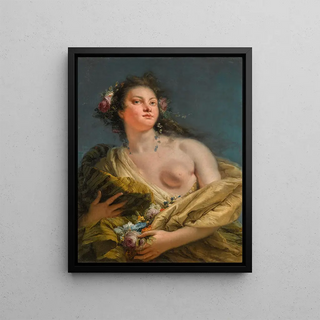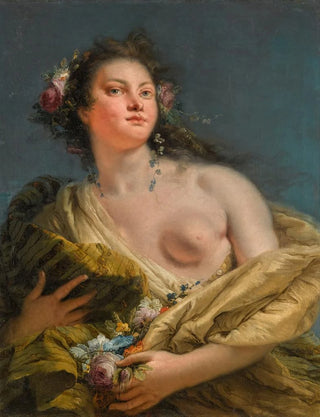Art print | Portrait of a lady in Flore - Giovanni Battista Tiepolo


View from behind

Frame (optional)
In the rich and intricate universe of baroque art, the "Portrait of a Lady in Flora" by Giovanni Battista Tiepolo stands out for its grace and elegance. This artwork, capturing the very essence of feminine beauty and nature, transports us to a world where art and life seem to merge. The depiction of a lady draped in a floral gown not only reflects the fashion of her time but also evokes a poetic sensibility that still resonates today. The light, colors, and meticulous details combine to offer an immersive visual experience, inviting the viewer to contemplate the delicacy of forms and the depth of emotions.
Style and uniqueness of the work
Tiepolo's style is characterized by an exceptional mastery of light and color, elements that are evident in this art print. The vibrant palette, blending delicate shades with bright nuances, creates an almost dreamlike atmosphere. The lady, whose face radiates softness, is highlighted by a floral background that seems to dance around her, symbolizing both femininity and harmony with nature. Every detail, from the movement of the gown to the subtle expressions on her face, demonstrates meticulous attention to the beauty of forms. By placing his subject in such a lush environment, Tiepolo manages to establish a dialogue between humanity and the natural world, making the art print both intimate and universal.
The artist and his influence
Giovanni Battista Tiepolo, an emblematic figure of the 18th century, left his mark by blending grandeur and delicacy. Originating from Venice, he established himself as one of the masters of rococo, influencing many artists across Europe. His innovative approach to composition and visual storytelling paved the way for new interpretations of portrait art. Tiepolo transcended the conventions of his time, incorporating narrative and symbolic elements that enrich his works with unprecedented depth. The "Portrait of a Lady in Flora" is not merely a depiction of a woman but an exploration of themes of identity

Matte finish

View from behind

Frame (optional)
In the rich and intricate universe of baroque art, the "Portrait of a Lady in Flora" by Giovanni Battista Tiepolo stands out for its grace and elegance. This artwork, capturing the very essence of feminine beauty and nature, transports us to a world where art and life seem to merge. The depiction of a lady draped in a floral gown not only reflects the fashion of her time but also evokes a poetic sensibility that still resonates today. The light, colors, and meticulous details combine to offer an immersive visual experience, inviting the viewer to contemplate the delicacy of forms and the depth of emotions.
Style and uniqueness of the work
Tiepolo's style is characterized by an exceptional mastery of light and color, elements that are evident in this art print. The vibrant palette, blending delicate shades with bright nuances, creates an almost dreamlike atmosphere. The lady, whose face radiates softness, is highlighted by a floral background that seems to dance around her, symbolizing both femininity and harmony with nature. Every detail, from the movement of the gown to the subtle expressions on her face, demonstrates meticulous attention to the beauty of forms. By placing his subject in such a lush environment, Tiepolo manages to establish a dialogue between humanity and the natural world, making the art print both intimate and universal.
The artist and his influence
Giovanni Battista Tiepolo, an emblematic figure of the 18th century, left his mark by blending grandeur and delicacy. Originating from Venice, he established himself as one of the masters of rococo, influencing many artists across Europe. His innovative approach to composition and visual storytelling paved the way for new interpretations of portrait art. Tiepolo transcended the conventions of his time, incorporating narrative and symbolic elements that enrich his works with unprecedented depth. The "Portrait of a Lady in Flora" is not merely a depiction of a woman but an exploration of themes of identity






